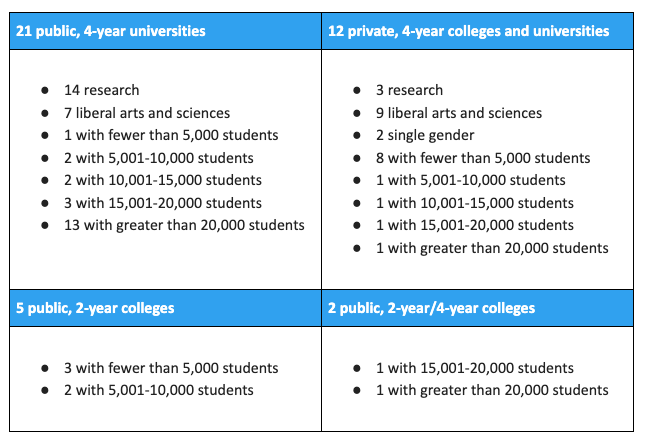7 min read
Lessons from 40 Learning Center & Tutoring Program Experts
By: Page Keller on Feb 7, 2023 3:41:34 PM

State of the Industry
Higher education has faced unprecedented challenges over the past few years. The COVID-19 pandemic upended typical business-as-usual practices and forced colleges and universities to seek out new methods of delivery for courses, programs, and services. The shift to remote learning happened almost overnight during spring 2020, and institutions were suddenly struggling with significant financial and enrollment challenges.
For collegiate learning centers and tutoring programs, these challenges forced leaders to also shift their business practices to a remote model. Moreover, they had to train administrative staff, professional staff, and student peer educators to utilize these new methods of service delivery. The learning curve may have been steep, but those on the delivery and receiving ends rose to the challenge.
Learning centers and tutoring programs hoping to be back to business-as-usual by now are grappling with issues that arose in response to the pandemic. During the fall 2022 semester, Knack met with 40 learning center and tutoring program managers to discuss their current practices, challenges, and hopes for the future. Here is what we learned.
Interviews Details
During the fall 2022 semester, we met with learning center directors and tutoring program managers across the country to learn more about how their tutoring programs operate. Encompassing 40 higher education administrators, our process included questions pertaining to program design, tutor recruitment and retention, tutor training, tutoring modalities, current challenges, and goals. Below is a breakdown of the school types and enrollments of the institutions participating in the interviews:

With the diversity of schools represented in the interviews, we were able to gather significant data and facts surrounding the current state of the industry. Practices may vary slightly; but unsurprisingly, the challenges faced by learning center directors and tutoring program managers were similar.
Current Practices
The interviews produced copious data and information pertaining to current practices in learning centers and tutoring programs. Provided below are high-level summaries of the key takeaways from our conversations.
Centralized vs. Decentralized
Of the 40 programs participating in the interviews, there were 25 serving as the sole learning center on their campus. Of those 15 programs living on campuses with multiple learning centers, the ones with whom I spoke were the largest or offered the most widely used services on campus. The majority of managers on campuses with decentralized programs referenced problems with the management of the other programs on campus, citing tutor training and supervision as the greatest concerns. One program director from a small, private, 4-year college said when he first arrived at the college, tutoring was decentralized and rogue. “Students tutored for whatever price they wanted to charge.” He convinced the administration that they needed to shift to a centralized model, and the institution complied with his recommendation.
Tutoring Modality
Thirty-four of the managers interviewed said they offer both in-person and virtual options for tutoring. Virtual tutoring was not an option at most schools prior to the pandemic. Of those that introduced virtual tutoring at the rise of the pandemic, most programs have retained a virtual one-on-one or drop-in component to provide choices for students. One director at a 4-year, public university shared that students in spring 2022 were not using the online drop-in tutoring offered by their center, so starting in fall 2022 they eliminated the option. The director said it is “potentially a problem for students enrolled in programs that are entirely online.” Several others referenced concerns about students who live off-campus or work during the day and are unable to visit the learning center during its hours of operation.
One-on-one tutoring is a far more utilized practice than drop-in labs and group tutoring. Thirty-one of the programs interviewed offer one-on-one tutoring, 28 offer group tutoring, 17 offer drop-in labs, and the majority of those offer a combination of services. The few who offer drop-in tutoring to support their students cited positives and negatives. One program manager said, “Pedagogically, we like the drop-in model because we like that students have the opportunity to collaborate in labs.” Others referenced space constraints which limit drop-in and group tutoring, and some said once they returned to campus after COVID bans were lifted, they eliminated drop-in and group tutoring for health and safety reasons.
Most tutoring programs provide tutoring for historically challenging, high DFW, or high demand subjects and courses. No tutoring program interviewed provides tutoring for all students in all subjects, but the vast majority provide options for students seeking help in unsupported courses. For example, some centers make an effort to find a tutor, others refer the student to other services like academic coaching, while many will refer to the academic department for additional assistance.
Types of Tutors
Peer tutoring is the most common practice within learning centers and tutoring programs today. Of the 40 programs, there were 35 with solely peer tutors serving their students. Those five schools employing professional and peer tutors are either 2-year colleges or colleges that serve mainly non-traditional students. Utilizing professional tutors is a common practice for schools enrolling mostly non-traditional students or for community/technical colleges, as it is difficult to recruit and retain peer tutors in both of those settings.
Recruitment and Hiring
All tutoring programs interviewed use similar methods for recruiting tutors. Most said nominations and referrals from faculty are the most effective recruitment techniques, but many also said advertising on social media and the campus online job board were also helpful. Still, others have resorted to old-school practices like sidewalk tabling or dining hall table tents, as tutor recruitment has become a challenge.
Specific selection criteria for tutors is set by each school. They each require a minimum cumulative GPA, minimum grade or demonstration of ability in the subject to be tutored, and interview. Some require letters of recommendation. About half of those interviewed incorporate at least the minimum criteria established by the College Reading & Learning Association (CRLA) International Tutor Training Program Certification (ITTPC), and 16 of those interviewed are CRLA certified up to Level 1, 2, or 3.
Tutor Training
All programs interviewed provide organized initial and ongoing training for tutors. Initial training varied from school to school. Some require tutors to enroll in credit-bearing courses, and others mandate an inservice prior to the start of the semester. Ongoing training throughout the semester ranged from required weekly/bi-weekly meetings to optional professional development. Those that are CRLA ITTPC certified utilize those guidelines based on standards and best practices in the field, while others mentioned that they use ITTPC training topics even though they are not certified.
Fifteen of the program managers said they use outsourced training platforms to better prepare their tutors. Some referenced platforms that require a fee to use, and others shared that they use our free training option built in accordance with ITTPC standards.
Program Marketing
By far, the most effective marketing strategies to advertise tutoring programs to the campus at-large is classroom presentations. Running a close second is faculty announcements and referrals. Social media, email blasts, digital signage, and flyers are also widely used, but partnerships with departments and faculty are the most successful tools used to drive “business” to the center.
Challenges
Topping the list of the greatest challenges currently faced by post-COVID learning centers is budgetary constraints. Budgets have been cut or partially eliminated altogether. For many, these budget cuts resulted in layoffs, so professional and administrative staffing is slim. Moreover, managers are finding it difficult to fill vacant positions because of low-pay. Thus, existing staff are doing more with less and are overwhelmed with performing the work of more than one person.
The second most common challenge is tutor recruitment and retention. The pandemic dramatically altered the way colleges and universities operate. It also changed the way in which students navigate the college experience. Many want to focus on their schoolwork since they feel underprepared as a result of learning lost during the pandemic. Other students who do want to work are choosing higher-paying, off-campus jobs.
Other challenges cited are physical space constraints, physical space visibility due to location, competing resources due to a decentralized model, low student enrollment, and under-utilization of services offered. The latter is an issue that arose during many of the interviews. While a handful of the programs are seeing usage that mimics pre-COVID numbers, others are struggling to get students in the door. Many referenced the need for a supplemental option to scale support on their campuses.
The Future of Learning Centers
Despite the changes and challenges faced by learning centers and tutoring programs since spring 2020, the leaders are overwhelmingly optimistic about the future of their programs. One director at a prestigious 4-year private college is working toward her goal of “a fully centralized model of tutoring, as opposed to what is currently practiced at this institution.” Another is eager to soon expand training to offer more robust learning experiences for their tutors. Nearly all of these managers’ hopes and dreams for the future involve providing the best possible programming and services to all of their tutors and tutees.
In this post-COVID world, learning center directors and tutoring program managers must avoid the “let’s get back to normal” approach but instead should consider the needs of students in this post-pandemic world. These are not the same students as before. For many, the events over the past few years disrupted their high school and/or college experience, and their expectations for service delivery, tutoring modality, and student employment options have changed dramatically.
To learn more about how to meet the needs of more students and scale student support on your campus, schedule a conversation with one of our peer tutoring experts today.
Related Posts
Leveraging Peer Coaching to Support Students’ Mental Health
While the types of peer programs on campuses vary, they all have one thing in common: whether it’s the program’s main focus or a by-product of the...
Adapting Academic Support for Asynchronous Learning
Acknowledging the existence of timezones and varying student circumstances, many schools have focused their efforts on adding in flexibility to...
How Tutoring Shapes Graduates for Life After College
As another commencement season arrives, campuses across the country are filled with celebration—and reflection. For students who engaged in tutoring...

